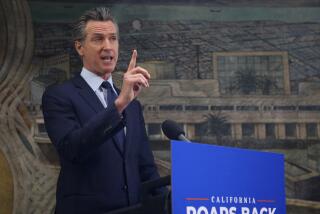Legislators Disagree on How to Do Census
- Share via
WASHINGTON — It is the biggest deployment of government personnel short of going to war, an event that requires years of planning and $4 billion to execute. Its results determine how much of the federal pie each state gets during the first decade of the 21st century, money that pays for everything from infant formula to new highways.
But with the 2000 census a little more than two years away--and with as much as $1 billion in federal money at stake for California--legislators have locked horns over how to do it. Haunting them are the sorry results of the 1990 census, which missed an estimated 4 million people and took its rueful place in history as the first decennial count to do a worse job than the one before it.
No state felt the undercount’s sting more painfully than California, which experts say lost out on at least $500 million in federal money and one congressional seat because of census inaccuracy.
At issue in Congress is the proposed solution to another undercount: a sampling method that would make every effort to tally residents by mail, phone or knocking on doors, then pick up the remaining few percent by statistical projection.
“Every American should count,” said Rep. Henry A. Waxman (D-Los Angeles), the senior Democrat on the House government reform committee that has jurisdiction over the census. “Sampling and other improvements will assure that California or any other state doesn’t have to use state funds to make up for the unequal distribution of federal dollars.”
But in the House, where the issue is expected to arise this week, the dispute about sampling is less statistical than political. GOP leaders charge that the technique violates a constitutional requirement that every resident be physically counted. Behind this legal argument, however, is concern that the undercounted are mostly ethnic minorities who tend to be Democrats. Thus, use of sampling could reduce the number of solidly GOP House seats that are carved out after the census.
Endorsed by the National Academy of Sciences, sampling is the only way to avoid repeating the mistakes of seven years ago, census officials say. Without it, they warn, the census will not only produce less accurate results, but will cost $1 billion more to carry out as the government dispatches thousands more enumerators to scour residential blocks for anyone missed.
Although it is an arcane subject to most, the census results continue to touch the lives of the nation’s masses 10 years after the tally is turned in. When federal riches are portioned out to the states, who gets how much is often based on population. Money for the federal supplemental nutrition program for poor women and children, for instance, is determined in part by the census count.
For California, analysts warn that an inaccurate count in 2000 could cost the state as much as $1 billion in federal money. Despite this, Gov. Pete Wilson and California’s Republican House members have been conspicuously quiet on the subject of sampling, testimony to the political thicket the issue poses.
“The governor’s goal at the end of the day is a more accurate enumeration. Whether or not sampling is the tool that gets you to that end is something that is still being determined,” said spokesman H.D. Palmer.
President Clinton, meanwhile, has been quite clear about his position. He vetoed a disaster-relief bill earlier this year after the GOP tacked on an amendment to ban the sampling, and says he’ll wield his pen again to protect the technique.
Still, time is on the GOP’s side.
*
A bill pending in the House that provides annual funding for the Commerce Department allots $382 million to prepare for the 2000 census, but would bar the Census Bureau from spending any of it on sampling.
A trial census--a sort of dress rehearsal conducted two years before the real thing--is scheduled for April 1998 in three sites in the country, one of them Sacramento. If the funding bill does not pass soon, census officials say, it will be too late to prepare for the dress rehearsal. And without such a dry run for sampling, they say, it would be irresponsible to employ the method in 2000.
“It means we will essentially do again in 2000 what we did in 1990--a census that cost more than it should and counted fewer people,” said Census Bureau Director Martha Farnsworth Riche. “Our goal in 2000 has been to count everyone and spend less money doing it.”
A bipartisan amendment to the bill attempts to appease both sides by freeing up the money for sampling while still giving Congress the option of banning the method in the 2000 tally. The Senate already has passed similar language.
“My definition of insanity is to continue to do something in the same way and expect a different result,” said Rep. Carolyn B. Maloney (D-N.Y.), one of the amendment’s sponsors.
A few House Republicans last week began to speak out in favor of sampling, bolstering Democratic hopes that the amendment will pass. But because the census is the basis for drawing political districts, many GOP House members face a dilemma--support sampling, and risk the loss of their seats, or oppose it and risk their state’s fair share of about $100 billion in federal funds.
One California political analyst said: “Republican legislators feel they must decide between their own reelection and the needs of their constituents.”
More to Read
Get the L.A. Times Politics newsletter
Deeply reported insights into legislation, politics and policy from Sacramento, Washington and beyond. In your inbox twice per week.
You may occasionally receive promotional content from the Los Angeles Times.










